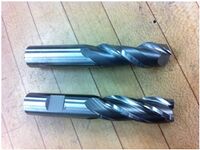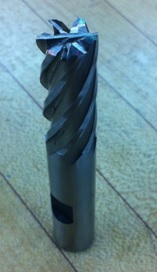Talk:Developers' Bulletin
5/31/13[edit source]
Highlights:Uploading videos, Guidelines for Pictures/Figures, Itemized/Step by step table, Description guidelines
Q&A[edit source]
There was a question regarding uploading videos. Please see Help:Page Editing (Quick) for more information.
Page discussions[edit source]
We went through and added comments to many of the pages, including:
Please incorporate comments by tomorrow midday.
Tomorrow I will be adding comments to:
- 90 Degree Mill Head
- Part Design (MakerBot)
- Code Generation (MakerBot)
- Machine Setup/Maintenance (MakerBot)
Pages not started[edit source]
- Tramming Mill Head
- 4th Axis (HAAS Mill)
- Mounting Tools (HAAS Mill)
- Squaring Rough Stock
- Micrometer Measurements
- Tumbler (C&M Topline)
- Boring Head
- Broach
- Sine Bar
- Rotary Table
Guidelines for Pictures/Figures[edit source]
- Figures and drawings are far superior than pictures and should be used when reasonable
- Mismatching of figures and images should be avoided
- Figures should approach McMaster quality of figures see: http://www.mcmaster.com/#end-mills/=mycaju
- Figures can be created in gimp, inkscape, SW or you choice of software
- If pictures are required:
- Try to make the group of pictures consistent. For example, the example table below has endmills laying down, and one standing up. This is bad practice!!!
- Groups of images (pictures or figures) should have the same aspect ratio, and when possible should be of 1.33:1 (or 4:3). see: http://en.wikipedia.org/wiki/Aspect_ratio_(image)#4:3_standard
- Use consistent backgrounds, and when possible white background (piece of printer paper works well). This allows for easy future editing of image like background removal through gimp or photoshop.
Itemized/Step by step table (ID Table)[edit source]
{| class="wikitable" style="text-align: left;"
|+ style="text-align: left;"| Caption
! style="text-align: left;"|Tool/Step!!style="text-align: left;"|Description
|-
| {{RowPicture|fileName=name.jpg|caption=End Mill|description=add description here}}
|}
This table is used to provide information that is itemized/Step by step. Usage[edit | edit source]
Example[edit | edit source]
<pre style="white-space: pre-wrap;
white-space: -moz-pre-wrap;
white-space: -pre-wrap;
white-space: -o-pre-wrap;
word-wrap: break-word;">
{| class="wikitable" style="text-align: left;"
|+ style="text-align: left;"| Various types of mill cutters:
! style="text-align: left;"|Tool/Step!!style="text-align: left;"|Description
|-
| {{RowPicture|fileName=Mill end.jpg|caption=End Mill|description=An endmill is a type of milling cutter, a cutting tool used in industrial milling applications. It is distinguished from the drill bit in its application, geometry, and manufacture. While a drill bit can only cut in the axial direction, a milling bit can generally cut in all directions, though some cannot cut axially. End mills are used in milling applications such as profile milling, tracer milling, face milling, and plunging.}}
|-
| {{RowPicture|fileName=Mill end Rough.jpg|caption=6 Flute End Mill|description=This is NOT a roughing end mill}}
|}
Special Considerations[edit | edit source]None |
Simply copy and paste the code as required. Lines 1,2,3 set up the table, remember to change the table caption (Various types of mill cutters:) and the table headers (Tool/Step and Description). Copy and paste the 6th and 7th row as needed to add rows to the table, remembering to change the fileName, caption, and description fields as needed. The 5th row is an example and may be deleted. If the table is used for 'step by step' procedures, format caption as the following: Step 1: Turn on the Machine.
- About this table
- This table uses a template named we created RowPicture which is called by using double brackets {{TemplateName}}. The template requires the necessary syntax to finish the row of the table.
Description guidelines[edit source]
All pages should include a short synopsis/description at the beginning directly under the page title. See any wikipedia page for an expample, or see Manual_Lathe. This section should also include:
- Any necessary 'Not to be confused with' statements (see code on Manual_Lathe for example of use of Distinguish template)
- Any necessary 'Skip to' statements (see code on Manual_Lathe for example)
- 'Main Article' statement (see code on Manual_Lathe for example of use of MainArticle template)

